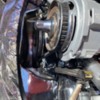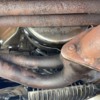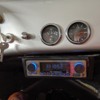Smoke on the headers is usually caused by leaking valve cover gaskets.
... or more likely from being pushed out the crank pulley. There's no seal back there, only a "slinger" and some grooves in the pulley - meant to meet with the oil, have a nice cuppa tea, and gently encourage it to consider going back to the sump. It doesn't work under the best of circumstances, and flings oil all over the back half of the car if you are overfilled or over-pressurized.
This is exhibit "C" in today's lesson: "why the oiling system was not the finest 15 minutes the Sainted German Engineers ever spent on a problem".
The impossibly small amount of oil these things carry (3-1/2 quarts of love, without an extended sump) is a thing very, very difficult to wrap your head around if you are used to anything besides a motorcycle or a Briggs and Stratton small engine. The oil level is absolutely critical, which is ironic, given that they leak oil and have no valve-stem seals (and therefore burn it).
Your typical small block Cheebie, by means of comparison, has an oil pan that'll hold about 2 gallons of oil and operates pretty much the same if it's two quarts low or a quart and a half high. That 3-1/2 quart band-o-fuzz, is the entire oil-system capacity of a stock T1 VW. Don't let it worry you, but that T1 VW really doesn't HAVE an oil pan, just a thimble-full of oil sloshing around in the bottom of the case. OK, so maybe it should worry you.
Check the oil level often. I recommend being OCD about it, but that's just me. If you aren't waking up in the night in a cold sweat, you probably aren't doing it right.
But what is right?
Keep in mind your dipstick was made with less pride than you might imagine by the lowest bidder in a mud hut somewhere in east Asia. The marks may (or may not) indicate the actual appropriate optimal oil level. You might want to run the level a little low (to keep oil from blowing all over the engine compartment from the lack of a crank seal), but not too low. The Sainted German Engineers assumed the average owner could handle it. They were wrong about other things as well, but nothing quite so important.
We talk a lot about what kind of oil to run, and very little about how much. Suffice it to say, enough of "whatever's on sale at Pep Boys" beats not enough of some secret sauce handed down from God, and delivered to your garage by means of a case of the elixir sitting on a velvet pillow held aloft on a litter carried by a hundred eunuchs. Every single time.
I'd recommend getting an oil pressure gauge, although most VW/replica guys don't think they are needed for some mysterious reason. What is unknown can't be a problem, apparently. All the real estate in the gauge cluster is taken up with the really important stuff, like a gas gauge that works about like a Magic 8-Ball, so you'll need to get a gauge that hangs off the bottom of your dash like that set you put on your '68 Nova back in high-school. Regardless, It seems to me that making sure you never starve the engine of oil during hard running or driving with verve and purpose is probably at least as important as trying to discern or guess what a petulant gas gauge is trying to hide from you.
Or not. Maybe you really just want to buy a fancier lawn mower engine (one with a designer label), and starving it of oil is the easiest way to accomplish that task with the last chance of failure (you know, to accomplish the goal - your engine will certainly fail if you run it out of oil). Mrs. 356_2cool2slow needn't know it was user error that brought about this state of affairs, it'll be our little secret.
So, to summarize: you need enough oil, but not too much. The dipstick is unreliable, and you probably have no gauge to tell you if you don't have enough oil. The only real way to know if you have too much oil is if it pukes all over the back of the car, and your driveway earns you a visit from the EPA hazmat team. Once you find the Goldilocks-Zone for oil, your engine will leak it or burn it, so you need to know where on the dipstick the proper level is, and check it like you're watching your IRA portfolio. You'll find yourself metering oil into the engine more carefully than you measured out your toddler's liquid Tylenol - adding an eighth of a quart every third fill-up, or some such thing.
Easy-peasy - nuthun' to it.
Oh, and welcome to the madness.






